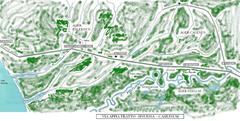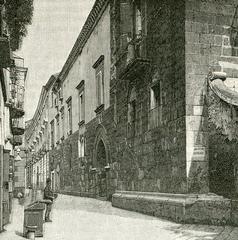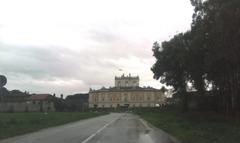Comprehensive Guide to Visiting Capua, Province of Caserta, Italy
Date: 13/08/2024
Captivating Introduction
Welcome to Capua, a mesmerizing blend of ancient history and modern charm in the heart of the Province of Caserta, Italy. Imagine wandering through streets where ancient Etruscan warriors once roamed, where gladiators fought to the roar of 60,000 spectators, and where every corner whispers tales of Roman emperors and medieval resilience. Capua isn’t just another stop on the tourist map; it’s a living museum that invites you to step back in time and relive its storied past. Picture yourself standing in the Capua Amphitheater, the second largest in Italy, or exploring the Museo Campano with its unique Matres Matutae statues. Each step you take in Capua is a journey through centuries of political intrigue, cultural evolution, and architectural splendor (Italy This Way, Britannica). Ready to uncover the secrets of this enchanting city? Let’s dive in!
Table of Contents
- Historical Overview
- Cultural Significance of Capua
- Introduction
- Historical Context
- Roman Era and Beyond
- Archaeological Significance
- Modern Cultural Heritage
- Culinary Heritage
- Festivals and Events
- Architectural Landmarks
- Modern Capua
- Visitor Tips
- Interactive Elements & Challenges
- Practical Information with a Twist
- Pop Culture References
- Time-Based Itineraries
- Local Lingo Lessons
- Seasonal Highlights
- Myth Busting and Surprises
- Storytelling Elements
- FAQ
- Call to Action
- Attractions in Capua
- Capua Amphitheater
- Museo Campano
- Capua Cathedral
- Mitreo di Capua
- Ponte Romano
- Chiesa di San Salvatore a Corte
- Palazzo Antignano
- Porta Napoli
- Teatro Ricciardi
- Parco delle Fortificazioni
- Hidden Gems and Insider Tips
- Time-Based Itineraries
- Cultural Context and Etiquette
- Seasonal Highlights
- Myth Busting and Surprises
- Call to Action
Capua: The Hidden Jewel of Italy’s History
Early Settlement and Etruscan Influence
Capua’s story begins in the 9th century BC, a tale told by the very soil beneath your feet. Picture bustling Etruscan marketplaces and grand necropolises with graves dating back to the mid-9th century BC. It’s a land where early whispers of Greek culture began to mingle with native traditions (Italy This Way).
Samnite and Roman Domination
Fast forward to the 5th century BC, and the Samnites take control of Capua. Picture the drama of the Samnite Wars, especially in 343 BC when Rome steps in to defend Capua. By 338 BC, Capua earns the title of ‘civitas sine suffragio,’ or citizenship without voting rights. Imagine a bustling hub of political and economic activity, filled with traders and vine growers who made Capua the toast of Campania (Britannica).
The Second Punic War and Decline
Capua’s strategic importance takes center stage during the Second Punic War (218–201 BC). Picture a city torn between Rome and Carthage, choosing to side with Hannibal. But after Hannibal’s defeat, Capua faces Rome’s wrath in 211 BC, losing political rights and seeing local magistrates replaced by Roman prefects. It’s the beginning of a decline for Capua (Britannica).
Roman Prosperity and Urban Development
Despite setbacks, Capua thrives. With the Appian Way connecting it to Rome in 312 BC, Capua becomes a melting pot of culture and commerce. Imagine the aroma of exotic perfumes and the shine of fine bronzes that made Capua famous. By 59 BC, Roman veterans from Julius Caesar’s campaigns settle here, adding to its rich tapestry. The Augustan period brings even more development, with the Aqua Iulia aqueduct quenching the city’s thirst (Britannica, Italy This Way, Academia).
Late Antiquity and Medieval Period
Capua shines brightly into the 4th century AD, earning a spot among the eight major cities of the Roman Empire, as poet Magnus Ausonius notes. But the Vandals in 456 AD and Muslim invaders around 840 AD leave their scars, sparing only the church of Santa Maria. The destruction leads to the birth of a new Capua in 856 AD, founded by Lombard count Landone I on a strategic bend of the Volturno River (Italy This Way, Britannica, Reggia di Caserta Unofficial).
Renaissance and Modern Era
Throughout the Lombard and Swabian periods, Capua stands as a fortress, a gateway to the South, enduring sieges and wars. Imagine the chaos of Cesare Borgia’s troops sacking the city in 1501. Over the centuries, Capua sees Austrian, Spanish, and French occupations, each leaving their mark. The Battle of Volturnus in 1860 brings Capua into the Kingdom of Italy (Reggia di Caserta Unofficial, Wikipedia).
Cultural and Archaeological Significance
Modern Capua, built on the ancient site of Casilinum, is a treasure trove of history. Picture wandering through the Museo Campano, marveling at the Matres Matutae statues, symbols of family and fertility. Stroll down Corso Appio, past the 16th-century Town Hall and the Church of Saint Eligi. Feel the medieval spirit in the city’s historic center, with its Lombard churches and the unfinished bell tower of S. Eligio. And don’t miss the Placito Capuano, the first document in the Italian vernacular penned in 960 AD (Reggia di Caserta Unofficial, Italy This Way).
In summary, Capua is not just a city; it’s a journey through time. From its Etruscan roots to its Roman grandeur and medieval resilience, Capua invites you to explore its rich tapestry of history and culture.
Cultural Significance of Capua
Introduction
Picture this: a city where ancient tales echo through timeworn streets, where every corner is a portal to the past, and where history feels alive. Welcome to Capua, a mesmerizing mix of gladiatorial legends, imperial grandeur, and mouthwatering culinary traditions.
Historical Context
Capua, nestled in the northern Italian region of Campania, now known as the province of Caserta, boasts a history as rich as its soil. Founded by Heracles, the legendary son of Hercules, in 1207 BC, Capua has been a beacon of political, religious, and military might through various epochs (Learn Ancient Rome). By the Social War (90-88 BC), Capua had morphed into a bustling Roman colony, its port and aqueduct system the lifeblood of commerce.
Roman Era and Beyond
Fast forward to the Roman Empire, and Capua’s star continued to rise. In the 1st century BC, General Sulla’s siege was famously lifted thanks to the generosity of Capua’s citizens (Learn Ancient Rome). By the 2nd century AD, Capua was part of the Roman imperial province of Italy, annexed by the Roman Empire in AD 42. Imagine a city known for its opulence, agriculture, and as a political and religious stronghold. After the Roman Empire’s fall, Capua witnessed conquests by the Visigoths and Lombards before becoming part of the Kingdom of Naples in the 13th century. Modern Capua, founded on Casilinum’s site in AD 856 by ancient Capua’s citizens, bears the scars and glory of its storied past (Britannica).
Archaeological Significance
Today, Capua is a treasure trove for archaeology enthusiasts. Beneath its surface lies a wealth of Roman-era artifacts, with the majestic amphitheater standing out as the second largest outside Rome (Learn Ancient Rome).
Modern Cultural Heritage
In contemporary times, Capua remains a cultural gem. Tourists flock to marvel at its archaeological marvels and historical artifacts. The Museo Archeologico, with its multimedia exhibits and interactive displays, offers a captivating journey through Capua’s rich history (Learn Ancient Rome).
Culinary Heritage
Capua’s culinary delights are a testament to its Roman heritage. Picture savoring dishes like pizza, pasta, and fish cappuccio, each bite a journey through time. The world-famous Larder of Capua, established in the 16th century, is a must-visit for its cured meats, artisan cheeses, and other delicacies enshrined as a national landmark (Learn Ancient Rome).
Festivals and Events
Capua’s festivals are a vibrant celebration of its heritage. The Mirth of Capua is a food lover’s paradise, while the Festival of the Black Pig honors the region’s pig-rearing tradition. These events offer visitors a chance to immerse themselves in local culture and traditions (Learn Ancient Rome).
Architectural Landmarks
The medieval charm of Capua is evident in its architectural landmarks. The cathedral, founded in 856 and rebuilt after 1943, stands as a testament to the city’s resilience. Other landmarks include the Norman castle (1050) and the towers of Frederick II’s castle (1239), each narrating a chapter of Capua’s history (Britannica).
Modern Capua
Modern Capua mirrors its ancient predecessor, strategically located at the convergence of the Volturno and Calore rivers. Stroll down Via Garibaldi and Via Pontano, and feel the echoes of Roman history (Learn Ancient Rome).
Visitor Tips
Planning a visit to Capua? Here are some tips for an unforgettable experience:
- Timing: Visit during spring or autumn for pleasant weather and cultural festivals.
- Transportation: Capua’s excellent road and rail connections make it easily accessible from cities like Naples.
- Accommodation: From budget-friendly hotels to luxurious stays, Capua caters to all preferences and budgets.
- Local Cuisine: Indulge in local delicacies, especially cured meats and artisan cheeses from the Larder of Capua.
- Guided Tours: Opt for guided tours of archaeological sites and museums for deeper insights into Capua’s rich history.
Interactive Elements & Challenges
To truly immerse yourself in Capua’s history, why not embark on a scavenger hunt? Seek out key landmarks like the ancient amphitheater, the Norman castle, and the majestic cathedral. Or, take on a culinary quest to try specific local dishes like fish cappuccio and artisan cheeses. Each discovery brings you closer to the heart of Capua.
Practical Information with a Twist
- Timing: Spring or autumn? Perfect! Capua’s festivals will shine bright under the mild sun.
- Transportation: Capua’s public transport is as reliable as a Roman aqueduct.
- Accommodation: From charming B&Bs to swanky hotels, Capua has options for every traveler.
- Local Cuisine: Picture this: a feast fit for a Roman emperor! Don’t miss out on the Larder of Capua’s cured meats.
- Guided Tours: History buffs, rejoice! Expert guides will unveil Capua’s secrets, one story at a time.
Pop Culture References
Ever seen the TV series ‘Spartacus’? Capua is where it all began! Imagine walking the same streets as the legendary gladiator. Or recall the epic scenes from ‘Ben-Hur’; Capua’s amphitheater brings those moments to life.
Time-Based Itineraries
Why not explore Capua through themed itineraries? Choose a ‘Gladiator’s Day Out’ to visit the amphitheater and enjoy a hearty Roman feast. Or perhaps a ‘Cultural Connoisseur’s Path’ through museums and historical landmarks. Each path offers a unique adventure.
Local Lingo Lessons
Want to impress the locals? Here are a few phrases to get you started:
- Buongiorno (bwohn-JOR-noh) – Good morning!
- Grazie (GRAHT-see-eh) – Thank you!
- Dov’è il bagno? (DOH-vehl BAH-nyoh) – Where is the bathroom?
Seasonal Highlights
Capua’s charm varies with the seasons. Spring brings blooming flowers and vibrant festivals, while autumn offers a harvest of gastronomic delights. Summer is perfect for sun-soaked explorations, and winter turns the city into a cozy, festive wonderland.
Myth Busting and Surprises
Did you know Capua was once considered more influential than Rome? It’s true! Or that it’s home to one of the best-preserved Roman amphitheaters? Capua is full of surprises waiting to be uncovered.
Storytelling Elements
Imagine walking through Capua’s streets as the sun sets, hearing tales of Roman generals and gladiatorial combats whispered by the winds. Feel the thrill of uncovering a hidden alley that once led to an ancient market. Capua isn’t just a place; it’s a living story.
FAQ
- What’s the best time to visit Capua? Spring or autumn for mild weather and lively festivals.
- Is Capua family-friendly? Absolutely! There are plenty of activities for all ages.
- How do I get around Capua? Public transportation and walking are the best ways to explore.
- Can I find vegetarian options in Capua? Yes, the local cuisine offers a variety of vegetarian dishes.
Call to Action
As your journey through Capua draws to a close, you might find yourself standing on the ancient Ponte Romano, reflecting on the layers of history you’ve traversed. From the bustling Etruscan marketplaces and grand Roman amphitheaters to the medieval churches and Renaissance palaces, Capua is a testament to resilience and rebirth. Whether you marveled at the intricate frescoes of the Mitreo di Capua or savored local delicacies at the Larder of Capua, each experience is a thread in the rich tapestry of this remarkable city. Capua’s history is not just preserved in its monuments but is alive in its festivals, culinary traditions, and the warm greetings of its residents. So why stop here? With Audiala, your journey through Capua’s hidden gems and historical wonders can continue, offering expert insights and a deeper connection to this timeless city. Download Audiala now and let the adventure begin (Learn Ancient Rome, Reggia di Caserta Unofficial).
Attractions in Capua, Province of Caserta, Italy
Capua Amphitheater
Picture this: you’re standing where 60,000 Romans once cheered for gladiators. The Capua Amphitheater, the second-largest in Italy (only the Colosseum is bigger), is a colossal structure from the 1st century AD. Explore the underground passages where gladiators and wild beasts waited for their turn in the arena. The on-site museum is a treasure trove of artifacts and statues. Find out more on the official website.
Museo Campano
Step into the Museo Campano, an Aladdin’s cave of ancient artifacts in a former convent. Marvel at the Matres Matutae, unique mother goddess statues you won’t find anywhere else. The museum’s Roman mosaics, inscriptions, and everyday objects offer a vivid glimpse into ancient Capuan life. Check out the Museo Campano for more details.
Capua Cathedral
Behold the Capua Cathedral, a Romanesque masterpiece originally built in the 9th century. With its frescoes, marble columns, and awe-inspiring altar, the cathedral is a feast for the eyes. The crypt, dating back to early Christian times, is a must-visit. It’s an active place of worship, so feel free to join a service or simply soak in the beauty. More info on the diocese website.
Mitreo di Capua
Delve into the mystical Mitreo di Capua, an underground temple dedicated to the god Mithras, discovered in 1922. The 2nd-century AD frescoes depict Mithraic mythology, including the iconic scene of Mithras slaying the bull. Due to its delicate condition, access is limited, so book in advance. Visit the official site for details.
Ponte Romano
Take a walk across the Ponte Romano, an ancient bridge over the Volturno River, built in the 1st century BC. Its stone arches are a testament to Roman engineering. This spot offers unique perspectives on Capua’s historical landscape and is perfect for photos. Learn more here.
Chiesa di San Salvatore a Corte
In the heart of Capua is the Chiesa di San Salvatore a Corte, a 10th-century church known for its Lombard-Romanesque architecture. Inside, discover beautiful frescoes and a stunning wooden ceiling. Climb the bell tower for panoramic views of the city. This active parish welcomes visitors. More info on the church’s website.
Palazzo Antignano
Palazzo Antignano, Capua’s town hall, is a Renaissance gem from the 16th century. Explore its grand courtyard, elegant staircases, and beautifully decorated rooms. The palace hosts cultural events and exhibitions. Visit the official website for more details.
Porta Napoli
Porta Napoli, one of Capua’s ancient gates, dates back to the Roman period. Adorned with intricate carvings and inscriptions, it was once the main entrance to the city. It’s a must-see for history buffs. Learn more here.
Teatro Ricciardi
Teatro Ricciardi, a historic theater from the 19th century, hosts plays, concerts, and operas. Its elegant interior with ornate decorations and plush seating makes for a charming cultural venue. Check the schedule and book tickets on the Teatro Ricciardi website.
Parco delle Fortificazioni
Parco delle Fortificazioni is a serene green space around Capua’s ancient city walls. Enjoy walking paths, picnic areas, and scenic views. The fortifications highlight Capua’s strategic historical importance. Explore the remnants of the walls and towers while enjoying the natural beauty. More info here.
Hidden Gems and Insider Tips
- Via Appia Antica: Stroll along this ancient Roman road lined with archaeological treasures.
- Local Markets: Dive into local life with fresh produce and handmade crafts at bustling markets.
- Secret Courtyards: Seek out hidden courtyards for quiet retreats and beautiful architecture.
- Festivals and Events: Check Capua’s calendar for vibrant festivals and cultural events.
- Local Etiquette: A friendly greeting goes a long way in Italy. Don’t forget your pleasantries!
Time-Based Itineraries
Morning Glory: Start with a walk across Ponte Romano and a visit to the Capua Amphitheater. Grab a coffee at a local café.
Afternoon Adventure: Explore Museo Campano and have lunch at a trattoria. Wander through the Chiesa di San Salvatore a Corte.
Evening Enchantment: Catch a performance at Teatro Ricciardi and enjoy a stroll in Parco delle Fortificazioni.
References
- Italy This Way, 2023 source url
- Britannica, 2023 source url
- Learn Ancient Rome, 2023 source url
- Reggia di Caserta Unofficial, 2023 source url








